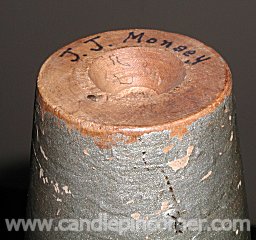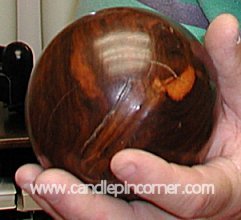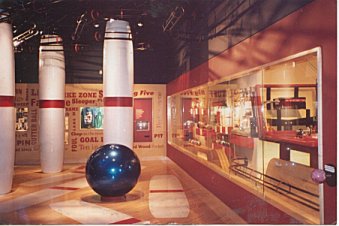"CANDLEPIN
101"
A little history lesson
for our friends.
The first candlepin on the left is a replica of what J.P. White found in his new aquired bowling & billiard establishment, the Pearl Street Alleys, back in 1879. The untapered pin (#1) was 1" round by 10" long and was set on spots 10 inches apart. You might think this would have been easy but not a chance when 3 inch diameter balls (#9) were used.
J.P. White found that bowlers weren't happy with the difficult task of knocking down pins the size of broomsticks. Not wanting to lose his investment in the bowling business, White decided to create a new pin that would give a variety of interesting different leaves on the pin deck. In 1880 history was made with the invention of the CANDLEPIN (pin #2) measuring 2 inches by 12 inches and being tapered to 1 inch at the ends. White made a standard 4 inch ball to be used with new candle-shaped pin and bowlers instantly loved his new game.
Pins 3 & 4 are real pins used in the early 1900's. They are similar to the pins of todays game, measuring close to 3 inches diameter around the middle and 15 1/2 inches tall. They were set on 11 inch spots and used with 4 1/2 inch balls. At that time in the game there were many people producing pins, and though quite similar, none were exactly the same. A man by the name of Jack Monsey, an employee of
J.P. White, eventually became one of the biggest forces in development of standards for the game. Many of those standards are still used today.
In 1928 pins (#5) were painted white to improve their rather dull looking appearance. It was a great improvement for most who bowled in dark basements.
The 50's brought about the greatest changes to the development of the candlepins as we know them today. First were the addition of plastic caps in 1952 ( the 6th pin) to protect the ends from splintering. The 7th pin, also a wooden pin, was entirely plastic coated to help protect extend the life expectancy of the maple underneath.
In 1960, high impact plastic technology saved many proprietors in the candlepin industry from going out of business. The higher cost of these pins (#8) was greatly offset by the long lifespan of 15 + years.
Other bits of interest to share

The pin with the tag on it and the covered ends (# 3) comes from Jack Monsey's private collection of bowling artifacts and was a gift to Bob Parrella by the late Lillian "Babe" Monsey, the last surviving member of the Monsey family.
The green & white ball (#10) above the Ebonite box is the first candlepin ball manufactured by the E.Parrella Co. in the early 50's

This ball (#11) on the top shelf is made of Lignum Vitae, the hardest wood in commercial use. Until the advent of high quality plastics and rubber compounds, lignum vitae was the material of choice for such items that must absorb great stress such as chisel handles, mallets, pulley sheaves, machine bushings, propeller shafts and BOWLING BALLS! The ball which dates back to 1910 given to Mr.Parrella by former Bowlmor President, Oscar Silverman.
HOPE YOU ALL ENJOYED THIS LITTLE BIT OF HISTORY ON THE GAME.
(Special thanks to Bob Parrella for showing us his great collection)we'll have a few more HISTORY 101 lessons to show in the future
_____________________
They
sure don't make em' like they used to!



